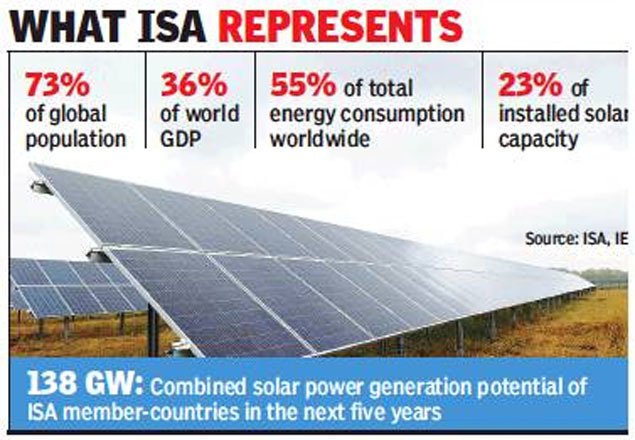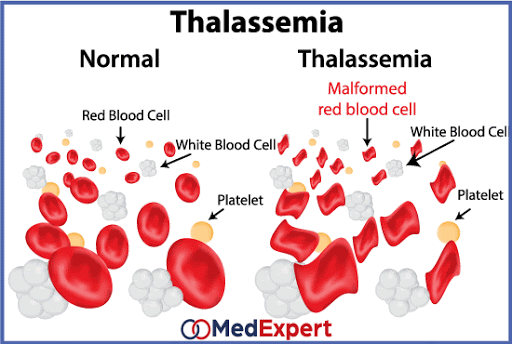Contents
- India and France: Elected President and VP at ISA
- Thalassemia Bal Sewa Yojna
- High-resolution Air Quality Early Warning System
- Single Window System Portal ‘Champions’
- National Awards for Excellence in PSU
INDIA AND FRANCE: ELECTED PRESIDENT AND VP AT ISA
Focus: GS-II International Relations
Why in news?
- India and France were re-elected as President and Co- President of the International Solar Alliance (ISA) for a term of 2 years at the third assembly of the ISA.
- Four new Vice-Presidents were also chosen to represent the four regions of ISA.
Details
The representatives who assumed the vice presidency were:
- Fiji & Nauru for Asia Pacific Region;
- Mauritius & Niger for Africa Region;
- UK & Netherlands for Europe and others Region,
- Cuba and Guyana for Latin America and Caribbean Regio
The Assembly also approved the initiatives of the ISA Secretariat in institutionalizing ISA’s engagement with the private and public corporate sector through the Coalition for Sustainable Climate Action (CSCA).
Highlights
- The President of the ISA Assembly – India’s Power and New and Renewable Energy Minister – said that Solar energy is already contributing around 2.8% of global electricity, and if trends were to continue, by 2030, solar will become most important source of energy for electricity production in large part of the world.
- The ISA assembly was presented the report prepared by the World Resources Institute (WRI) which identifies the sources of funds, opportunities and constraints, in scaling up solar investments and the contribution of ISA in assisting Member countries.
- Recently ISA has initiated programmes for segregation of demand for around 50 million Home Power Systems which will not only meet subsistence energy needs of the rural households but will also contribute to improving health services and availability of portable water.
- ISA has aggregated a demand for more than 270,000 solar pumps across 22 countries, more than 1 GW of Solar Rooftop across 11 countries, and more than 10GW of Solar Mini-grids across 9 countries under its respective programmes.
- A robust pipeline of more than US$ 5 Billion has been developed for solar energy applications to meet lighting, irrigation, drinking water and productive energy requirement of the ISA member countries, which have so far been largely deprived of modern energy services.
International Solar Alliance (ISA)
- The International Solar Alliance (ISA) is an alliance of 121 countries initiated by India, most of them being sunshine countries, which lie either completely or partly between the Tropic of Cancer and the Tropic of Capricorn.
- It is headquartered in India.
- The focus is on solar power utilization.
- The primary objective of the alliance is to work for efficient exploitation of solar energy to reduce dependence on fossil fuels.
- This initiative was first proposed by Indian Prime Minister, and was announced during COP21 held in Paris in 2015.
- The alliance is a treaty-based inter-governmental organization. Countries that do not fall within the Tropics can join the alliance and enjoy all benefits as other members, with the exception of voting rights.
- After the United Nations, it is the largest grouping of states world-wide.

THALASSEMIA BAL SEWA YOJNA
Focus: GS-II Social Justice
Why in news?
Union Minister for Health and Family Welfare launched the second phase of “Thalassemia Bal Sewa Yojna” for the underprivileged Thalassemic patients.
Highlights
- The Data on the prevalence of silent carriers for various Haemoglobinopathies show that it is 2.9-4.6% for β-Thalassemia, while it can be as high as 40% for sickle cell anaemia especially among the tribal population.
- Haemoglobin variants like HBE in eastern India can be as common as 3-50% which calls for more attention to these diseases.
Background to: Thalassemia Bal Sewa Yojna
- Launched in 2017, this scheme is a Coal India CSR (Corporate Social responsibility) funded Hematopoietic Stem Cell Transplantation (HSCT) program that aims to provide a one-time cure opportunity for Haemoglobinopathies like Thalassaemia and Sickle Cell Disease for patients who have a matched family donor.
- The CSR initiative was targeted to provide financial assistance to a total of 200 patients by providing a package cost not exceeding Rs. 10 lakhs per HSCT.
Basic objective
- Thalassemia Bal Sewa Yojna” is intended to provide a onetime cure opportunity.
- It is for those patients who have a suitable matched family donor.
- The project will primarily benefit underprivileged thalassemia patients who have a matched sibling donor.
- They are therefore eligible for bone marrow transplantation but do not have the financial resources to cover the cost of the procedure.
Thalassemia

- Thalassemias are inherited blood disorders characterized by decreased hemoglobin production.
- Symptoms depend on the type and can vary from none to severe.
- Often there is mild to severe anemia (low red blood cells or hemoglobin).
- Anemia can result in feeling tired and pale skin.
- There may also be bone problems, an enlarged spleen, yellowish skin, and dark urine.
- Slow growth may occur in children.
- Thalassemias are genetic disorders inherited from a person’s parents.
- There are two main types, alpha thalassemia and beta thalassemia.
- The severity of alpha and beta thalassemia depends on how many of the four genes for alpha globin or two genes for beta globin are missing.
- Diagnosis is typically by blood tests including a complete blood count, special hemoglobin tests, and genetic tests.
Prevalence in India
- Accurate data on the prevalence of thalassemia in India is not available but it is believed that there are 20 million carriers.
- There are nearly 10-12,000 children are born every year with thalassemia major in India.
- The prevalence of thalassemia in India is variable with the highest concentration of carriers in Western India.
Approaches to treat Thalassemia
- The standard management is regular transfusion and chelation which has to be continued as long as the child is alive. Most of the parents cannot sustain this for logistical reasons and cost. (Only 20-30% of patients who have a matched sibling donor can afford to have a transplant.)
- Hematopoietic Stem Cell Transplantation (HSCT) today offers an alternative to lifelong transfusion.
- It is a useful therapy especially in chelation (removing certain heavy metals from the bloodstream) for patients with thalassemia major.
- A bone marrow transplant is a onetime curative approach which has a 70 to 95% chance of success.
- However, the procedure is associated with risk of infection, regimen related toxicity, graft versus host disease and relapse.
HIGH-RESOLUTION AIR QUALITY EARLY WARNING SYSTEM
Focus: GS-III Environment and Ecology
Why in news?
- The Air Quality forecast model System for Integrated modelling of Atmospheric composition (SILAM) for India has been further improved by implementing global emission inventories for coarse and mineral-fine anthropogenic particulate matter at 10km resolution.
- A very high-resolution city scale model ENFUSER (ENvironmental information FUsion SERvice) for Delhi also has been operationalized to identify the air pollution hotspots and pollution upto street level.
Details
- SILAM and ENFUSER have been developed in technical collaboration with Finnish Meteorological Institute (FMI).
- The speciality of the ENFUSER is the high utilization of measurement data such as air quality observations, a detailed description of the road network, buildings, land-use information, high resolution satellite images, ground elevation and population data.
- The ENFUSER natively taps into the operative IMD’s regional SILAM access point.
- The SILAM models have been extensively validated against observations over Indian region.
- Air Quality forecast model WRF-Chem has also been updated with high-resolution land use land cover information to improve the air quality forecast.
SINGLE WINDOW SYSTEM PORTAL ‘CHAMPIONS’
Focus: GS-III Indian Economy
Why in news?
- The Ministry of MSME in a major initiative has onboarded latest IT tools of Artificial Intelligence (AI) and Machine Learning (ML) for providing assistance and solutions to the issues of Micro, Small, and Medium Enterprises (MSMEs). Ministry has implemented AI & ML on its robust Single Window System ‘Champions’ which was launched by the Prime Minister in 2020.
- CHAMPIONS stands for: Creation and Harmonious Application of Modern Processes for Increasing the Output and National Strength.
Single Window System ‘Champions’
- This multi-modal system has a portal at virtual level and technology equipped physical control rooms at around 69 locations of the country and it has emerged as one of the front runner platforms for the MSMEs in a very short span of time.
- Ministry has said that Intel and its technology partner have implemented the entire domain of AI & ML at their Champions portal totally free of cost.
- Intel have guided the Ministry for last five months in implementing some of the tools of AI & ML.
- This is helping them in understanding the issues in real-time which includes information intelligence and sentiment analysis based on widely available Social media and Online data.
- The second phase would be directed towards real-time grievance redressal and management.
- The single window system is basically for making the smaller units big by helping and handholding, in particular, by solving their problems and grievances.
Three basic objectives of the CHAMPIONS:
- To help the MSMEs in this difficult situation in terms of finance, raw materials, labour, permissions, etc.
- To help the MSMEs capture new opportunities in manufacturing and services sectors.
- To identify the sparks, i.e., the bright MSMEs who can withstand at present and become national and international champions.
NATIONAL AWARDS FOR EXCELLENCE IN PSU
Focus: GS-III Indian Economy
Why in news?
- The team of TRIFED Warriors has been working diligently towards the transformation of lives of the tribal population across the country and their unstinted efforts and initiatives got worthy recognition at the Virtual Edition of National Awards for Excellence – PSU 2020.
- Combined, the team won three Awards: two individual awards for the exemplary and inspirational leadership of Shri Pravir Krishna in the CEO of the Year and Visionary Leadership Award categories and a collective award in the Investment in Start-Ups Category.
National Awards for Excellence – PSU
Hosted by the World HRD Congress, the National Awards for Excellence – PSU recognize the outstanding initiatives taken by government departments, Public Sector units and industry leaders as they continue playing important roles in realising the country’s vision of a self-reliant economy and Aatmanirbhar Bharat.
What is a PSU?
- A state-owned enterprise in India is called a public sector undertaking or a public sector enterprise.
- Those companies that are owned by the union government of India or one of the many state or territorial governments or both.
- The company stock needs to be majority-owned by the government to be a PSU.





